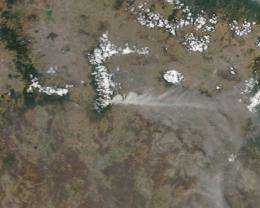One week of ash from Mexico's volcano

(Phys.org) -- Satellites continue to provide a look at the ash and gas clouds being emitted from Mexico's Popocatepetl Volcano. NASA has animated imagery from NOAA's GOES-13 satellite to provide a week long look at the volcano's activity.
"Most of the time, the prevailing westerly winds carry the debris (ash and smoke) far to the east in the mornings, while the daily rains bring down the ash before it can go far in the afternoon," said Dennis Chesters, of the NASA GOES Project at NASA's Goddard Space Flight Center, Greenbelt, Md.
NOAA's Geostationary Operational Environmental Satellite, GOES-13, captures visible and infrared images of weather over the eastern U.S. every 15 minutes, and spotted an ash and gas cloud streaming from Mexico's Popocatepetl Volcano over the period from April 14 through April 22, 2012. The one minute, 14 second black and white video covers shows the volcano's ash mostly blowing to the southeast. NOAA operates the GOES series of satellites, and NASA's GOES Project, at NASA Goddard compiles the images into animations.
Over the course of a week, the light brown cloud of ash and smoke can be seen streaming from Popocateptl, and then the white, puffy cumulus clouds develop in the afternoon and sometimes bring rain.
Popocatepetl is located about 34 miles (55 kilometers east of Mexico City. More than 30 million people live within sight of the volcano. "Popocatepetl" is the Aztec word for "smoking mountain," and is North America's second-highest volcano.
According to the U.S. Geological Survey (USGS), on April 17, the volcano's gas and ash plume reached a height of about 980 feet (~300 meters), spreading ash in the nearby town of Puebla. The Alert level at the volcano remains at "Yellow Phase Three," according to Mexico's National Center for Prevention of Disasters (CENAPRED).That alert means explosive activity could escalate, there may be growth of domes or expulsion of magma, and ash could rain on populated areas.
Provided by JPL/NASA



















